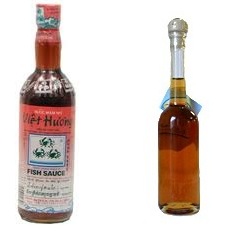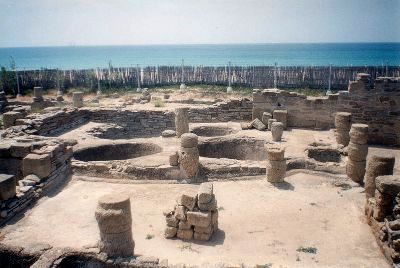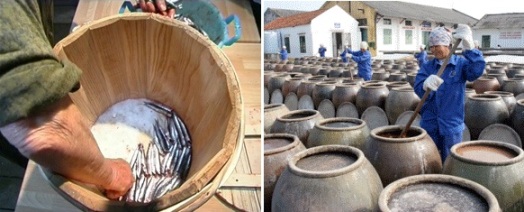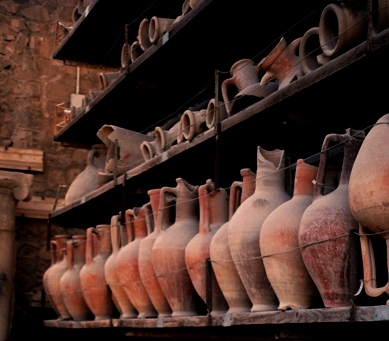You heard it here first folks: Over the course of the next six months or so, the kitchens of Chez Kelley are going to make fish sauce or Roman garum. More accurately, we are going to compare easy or quick methods with traditional outdoor fermentation. If we haven’t been run out of the neighborhood, we will report our results in an end of summer post.

I’ve been interested in making my own garum for a while now, and have a few traditional and modern recipes in hand to try. For those of you not familiar with this culinary wonder of the ancient world, it is a magical, translucent amber liquid that results from the fermentation of salted fish. When used with a heavy hand, the sauce understandably lends a fishy flavor to foods. When used with a lighter touch, it imparts a subtle, undeniably savory quality to dishes that is nothing short of absolutely delicious.
Interestingly, modern science has shown that analysis of remnants from ancient garum production from Pompeii has shown a pattern of free amino acids high in free glutamate followed by sweet-tasting glycine and alanine. These amino acid patterns are similar in modern Italian fish sauce (colatura di alici) and in some modern Asian fish sauces. Importantly, fish sauce doesn’t appear in Asia until well into the period known as the Early Middle Ages in Europe, almost 1,000 years after its documented use in the west. Its use in China and Japan diminishes after about the 14th Century ACE, because of the rise of soy sauces, but in Southeast Asia, fish sauce use remains strong to the present day. Umami is as savory does.
Like salt-baked fish, garum production started with the Phoenicians in Carthage who controlled the Mediterranean salt trade from Spain and Morocco across Europe and North Africa to the Levant and well into Western Africa. The largest installations in the western Mediterranean was located at Lixus, on the Atlantic coast of Mauretania (Morocco), with another one in New Carthage (Cartegena) in southern Spain. Spanish garum was renowned as being of the highest quality and was traded widely across the ancient world. The Black Sea (Euxine) was another prominent area for the production of garum. Pompeii was the home of a major garum processing industry. Here, the liquid from already fermented fish was diluted and flavored with a wide variety of substances including wine, must, vinegar, honey and multiple herbs and spices.

The earliest mention of garum fish sauce is to be found in the agricultural writings of the Carthaginian Mago which was translated into Greek (garos or garon) and Latin after the Second Punic War, but composed probably in the 6th or 5th Century BCE around the time of the rule of Magon. Cato the Elder mentions the trade of “Carthaginian fish sauce” in the 2nd Century BCE, and later descriptions can be found in The Deipnosophistae (The Philosopher’s Dining Table) by Athenaeus, I. 4b; II. 67f, c (3rd Century ACE). Athenaeus also mentions the remains of garum or liquamen production called allec which is not unlike the anchovy paste still used in Mediterranean cooking today.
Many different fish were used to make garum or liquamen in the ancient Mediterranean world with Tuna used during their seasonal migrations past Spain and Morocco, and mackerel, sardines and especially anchovies used during other times of the year. In fact, the remains of seasonally available fish from garum processing jars at Pompeii was the way that archaeologists confirmed the August date of the eruption of Vesuvius. Anchovies form the backbone of Asian fish sauce production for export, but many other local salt-water and inland fresh-water fish and shellfish are used for local and regional consumption.
The production of garum and Asian fish sauce is virtually the same as well. Fresh fish and salt in some proportion (recipes vary widely from 5:1 to 2:1) are layered in barrels, clay pits or earthenware crocks. Because of their large size, tuna were cut up before fermenting to prevent putrefaction, but most fish – especially the small species are processed whole and intact.
In Rome, oregano and other herbs were added at the production phase for both flavor and to suppress bacterial overgrowth, but this step is largely omitted in the production of Asian sauces. The vats are then left to ferment – sometimes covered or sometimes uncovered (Carthaginian and Roman) in the heat and stirred every few days to a week to ensure even enzymatic digestion of the fish. Basically the digestive enzymes of the very fresh fish digest themselves.
The period of time the fish are allowed to digest varies widely between ancient west and modern Asian production, but it ranges from about 3 months to almost 1 year. As the fish ferments and decreases in bulk, bricks or a weighted bamboo mat is placed on top of the mass and presses down on the fish. When completed, the vats are siphoned from the bottom, or drainage holes opened in the bottom and the liquid is allowed to drain out. Multiple simple filtrations later, and the translucent amber fluid begins to emerge. In both east and west, the first draft is considered the highest quality sauce. Lastly the fluid is diluted with water to different degrees for culinary use. As stated above, the fish paste that remains after the garum or fish sauce is withdrawn is also used in the kitchen.

Ancient Romans flavored their garum extensively. For example, one recipe for oenogarum is a 1:1 dilution of garum with must from sweet white wine. This basic recipe can be augmented with both vinegar and pepper, or with crushed garlic, vinegar and salt. Other recipes have garum mixed with red wine must, vinegar, mint, coriander and honey. Commonly used herbs to flavor garum included dill, coriander, fennel, celery, mint, oregano – depending on what the garum was going to be used for. Oxygarum was garum diluted primarily with vinegar and meligarum was garum cut primarily with honey. Modern Italians combine the basic colatura with herbs and other flavors during the cooking process, but generally don’t flavor the fish sauce directly. For example, I cooked a pasta dish last night that had colatura, garlic, lemon zest, capers, chives and parsley in an extra-virgin olive oil base – it was divine.
Like the Ancient Romans, modern Asians use prepared fish sauce a lot. Vietnamese nuoc mam cham is a great example of this. Recipes for nuoc mam cham (or just nuoc cham) vary a great deal from region to region (and from family to family) but generally have some combination of nuoc mam, lime juice, garlic, chili peppers, rice vinegar and oftentimes sugar. There is also nuoc mam gung in which ginger and peanut or sesame oil is used to flavor the nuoc mam along with lime juice and chilis. The Cambodian tuk trey has similar ingredients to nuoc cham, but adds pounded peanuts to the mix. The Japanese shottsuru mixes fermented fish sauce with malted rice for a darker, deeper fish sauce and in the Philippines; people use calamansi citrus or lemon and pepper to flavor their fish sauce patis.
So, once again, we can identify a product that flowed from west to east and was eagerly adopted by Asians on the Silk Road. The recipes for garum changed and adapted as they moved east and became nuoc mam and nam pla according to cultural preferences and what gifts the Asian seas had to offer. Archaeologists and food scientists are working to confirm these flow and linkages, so stay tuned to this channel to learn more about garum production in the ancient world and in the kitchen of Chez Kelley. Right now, I’ve got to run, my husband is preparing a rocking Parsi salad with fresh turmeric, onions, cucumbers, tomatoes and lime juice that smells incredible! (Words and Photo of Garum Amphorae from the Pompeii Pottery by Laura Kelley; photo of Modern Asian and Italian Fish Sauces from commercial culinary sites; Garum Production Facility near Cadiz, Spain from Wikimedia, and the photos of colatura and nuoc mam production from Google images).


1 thought on “Culinary History Mystery #3: Garum & Nuoc Mam”